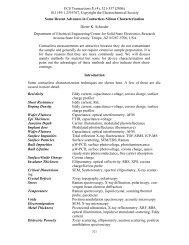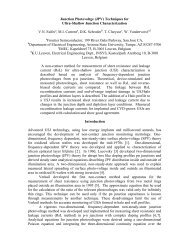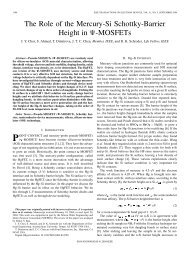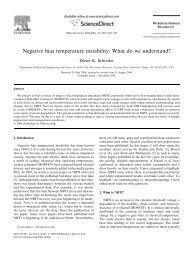Carrier Lifetimes in Silicon - Dieter Schroder - Arizona State University
Carrier Lifetimes in Silicon - Dieter Schroder - Arizona State University
Carrier Lifetimes in Silicon - Dieter Schroder - Arizona State University
Create successful ePaper yourself
Turn your PDF publications into a flip-book with our unique Google optimized e-Paper software.
SCHRODER: CARRIER LIFETIMES IN SILICON 167<br />
Fig. 15. L n;e versus N T for E T =0:4eV;p o =10 15 cm 03 ; n =<br />
2210 014 cm 2 ; p =5210 016 cm 2 ; =0:01;t = 650 m;T = 300<br />
K. The experimental data sources are shown on the figure.<br />
Fig. 16. r;e and L n;e versus t for r =20s;L n = 265 m, and<br />
s r = 1000 cm/s.<br />
as low as 1 cm/s have been observed [19]. Immers<strong>in</strong>g a bare Si<br />
sample <strong>in</strong> one of several solutions can reduce even below<br />
this value. For example, immersion <strong>in</strong> HF has given<br />
cm/s [22]. Immers<strong>in</strong>g the sample <strong>in</strong> iod<strong>in</strong>e <strong>in</strong> methanol has<br />
given cm/s [23]. In a series of experiments, a<br />
float-zone Si sample was immersed <strong>in</strong> concentrated HF, then<br />
removed and the was measured as a function of time.<br />
Subsequently the sample was immersed <strong>in</strong> an iod<strong>in</strong>e-saturated<br />
ethanol solution, removed and then measured. The values of<br />
<strong>in</strong> air follow<strong>in</strong>g the removal of the sample from either<br />
solution were cm/s for the HF-passivated surface<br />
and cm/s for the iod<strong>in</strong>e-passivated surface [24].<br />
The m<strong>in</strong>ority carrier diffusion length is, of course, also<br />
affected by surface recomb<strong>in</strong>ation. We show <strong>in</strong> Fig. 15 a plot<br />
of versus as a function of<br />
similar to the plot of Fig. 12. Also shown <strong>in</strong> Fig. 15 is<br />
the thickness m used <strong>in</strong> the calculation of (14).<br />
In diffusion length measurements by techniques like surface<br />
photovoltage, it is usually assumed that the longest diffusion<br />
length that can be reliably measured for a wafer of thickness<br />
is This l<strong>in</strong>e is also <strong>in</strong>dicated on Fig. 15.<br />
The experimental data po<strong>in</strong>ts for Fe <strong>in</strong> Si <strong>in</strong> Fig. 15 give<br />
reasonably good agreement with the calculations. We have<br />
aga<strong>in</strong> the question of the state of the Fe, i.e., Fe or Fe-B.<br />
The sample needs to be fairly thick to obta<strong>in</strong> the true recomb<strong>in</strong>ation<br />
lifetime or true m<strong>in</strong>ority carrier diffusion length,<br />
especially for samples with low impurity densities. This is<br />
illustrated <strong>in</strong> Fig. 16, where both and are shown as<br />
a function of sample thickness. Note that the usual assumption<br />
of is observed. In fact the sample needs to be on<br />
the order of 0.3-cm thick to reach true and for this<br />
example. Certa<strong>in</strong>ly, if the sample is th<strong>in</strong>ner than special<br />
precautions must be followed to extract the true lifetime or<br />
diffusion length from the experimental data. This is possible to<br />
do, but not rout<strong>in</strong>ely used. It was recently shown that diffusion<br />
lengths exceed<strong>in</strong>g the sample thickness by as much as a factor<br />
of 2.5 can be extracted with the appropriate analysis [25].<br />
If such analyzes are not used, then erroneous lifetimes or<br />
diffusion lengths may be obta<strong>in</strong>ed. This po<strong>in</strong>t of sample thick-<br />
Fig. 17. r;e determ<strong>in</strong>ed from photoconductance decay and surface photovoltage<br />
measurements. Data after [18] and [26].<br />
ness, surface recomb<strong>in</strong>ation velocity, and comparison between<br />
PCD and SPV was recently addressed. <strong>Lifetimes</strong> determ<strong>in</strong>ed<br />
by these two techniques agree, provided the experimental data<br />
are properly analyzed. Examples of such correlation are shown<br />
<strong>in</strong> Fig. 17, with diffusion length data obta<strong>in</strong>ed from SPV<br />
measurements converted to lifetimes [18], [26].<br />
B. Generation Lifetime/Surface Generation Velocity<br />
Generation lifetime measurements are usually made with<br />
a pulsed MOS capacitor (MOS-C) or a reverse biased pn<br />
junction. The various generation mechanisms of a reversebiased<br />
junction are shown <strong>in</strong> Fig. 18. They are similar <strong>in</strong> an<br />
MOS-C. Generation rate is 1) due to R–G centers <strong>in</strong> the scr;<br />
2) due to <strong>in</strong>terface traps at the SiO Si <strong>in</strong>terface; 3) due to<br />
R–G centers <strong>in</strong> the quas<strong>in</strong>eutral bulk; and 4) due to the back<br />
surface. The generation rate for the various mechanisms can<br />
be written as [27]<br />
(20)<br />
where the diffusion length is an effective diffusion<br />
length that couples the bulk diffusion length [mechanism<br />
(3)] with the surface generation velocity at the back surface








